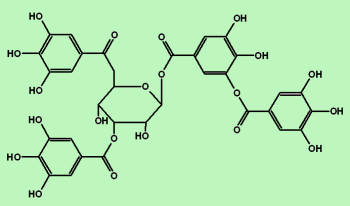|
What is Tannic Acid?Tannic acid is a polymer of gallic acid molecules and glucose. It the example there are 3 gallic acid molecules, but normally there are about 8. Because there are different molecular structures for tannic acid it would have been better to speak about tannic acids (in plural). Tannic acid will hydrolyze into glucose and gallic or ellagic acid units. Tannic acid is odourless but has a very astringent taste. Pure tannic acid is a light yellowish and amorphous powder. DistributionTea, nettle, wood, berries, Chinese galls. Oak wood is very rich in tannic acid. When wine is kept in oak kegs some tannic acid will migrate into the wine. High levels of tannic acid are found in some plant galls. These are formed by plants when they are infected by certain insects. These insects pierce the plant leaves and when the egg hatches out into a larva the plant produces a gall which surrounds the larva. Health Benefits of Tannic AcidTannic acid has anti-bacterial, anti-enzymatic and astringent properties. Tannic acid has constringing action upon mucous tissues such as tongue and inside of mouth. The ingestion of tannic acid caused constipation and can be used to treat diarrhoea (in the absence of fever or inflammation). The anti-oxidant and anti-mutagenic properties of tannic acid are beneficial. However, tannic acid should not be used continuously or in high quantities ad it slows down the absorption of iron and possibly other trace minerals. A study by Afsana K et al entitled Reducing effect of ingesting tannic acid on the absorption of iron, but not of zinc, copper and manganese by rats. published by Bioscience, Biotechnology, and Biochemistry (March 2004) concluded that the usual intake of polyphenols is relatively safe, but that a high intake by supplementation or by dietary habit of tannin affects only the iron level. Tannic acid can also reduce the effectiveness of digestive enzymes. Externally, tannic acid is used to treat ulcers, toothache and wounds. Facts about Tannic AcidTannic acid is also used in many industrial applications. The best known is the tanning of leather. Tannic is acid is sometimes used to clear wines. Tannic acids reacts with proteins in wine to form insoluble complexes which sediment or can be filtered. SynonymsGallotanic acid, digallic acid, allotannin, tannimum. |
